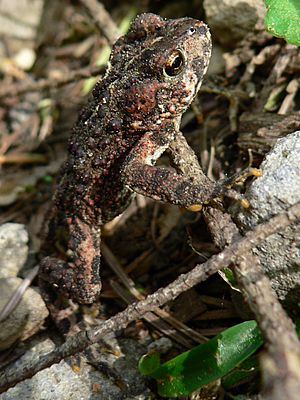Amphibians and reptiles of Yellowstone National Park facts for kids
Yellowstone National Park is a huge and amazing place, but it's a tough spot for some animals to live. For example, it's home to just four types of amphibians and seven kinds of reptiles. None of these species are in danger of disappearing, which is great news!
The main reason there aren't more amphibians and reptiles in Yellowstone is because of the park's cold and dry weather. Much of the park was shaped by glaciers long ago, and it still has very cold winters and dry conditions, which aren't ideal for these cold-blooded creatures.

Contents
Amphibians and Reptiles in Yellowstone
Amphibians and reptiles are both fascinating groups of animals. They are often called "cold-blooded" because their body temperature changes with the temperature around them. This means they need to find warm spots to heat up and cool spots to chill out.
What are Amphibians?
Amphibians are animals like frogs, toads, and salamanders. They usually start their lives in water, like tadpoles, and then move to land as adults. They need moist environments because their skin helps them breathe and can dry out easily.
In Yellowstone, the four amphibian species have adapted to the park's unique conditions. They often live near ponds, lakes, and streams where they can find the water and moisture they need. The Boreal Toad is one example of an amphibian that calls Yellowstone home.
What are Reptiles?
Reptiles include animals like snakes, lizards, and turtles. Unlike amphibians, reptiles have scales and typically lay eggs on land. Their skin is tougher and helps them keep moisture inside, so they can live in drier places.
Yellowstone's seven reptile species are also specially adapted to the park. You might find snakes basking in sunny spots to warm up. Even though the park is generally cold and dry, these reptiles find specific habitats where they can thrive.
Why So Few Species?
Compared to warmer, wetter places, Yellowstone has a relatively small number of amphibian and reptile species. This is mainly due to two big reasons:
- Glacial History: Long ago, huge glaciers covered much of Yellowstone. When these glaciers melted, they left behind a cold environment.
- Cold and Dry Climate: Even today, Yellowstone experiences very cold winters and often dry summers. Amphibians and reptiles struggle in extreme cold, and many also need moisture to survive.
Despite these challenges, the amphibians and reptiles that do live in Yellowstone are important parts of the park's ecosystem. They show how life can adapt and survive even in tough conditions!
See Also

